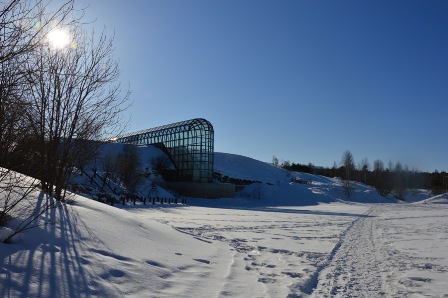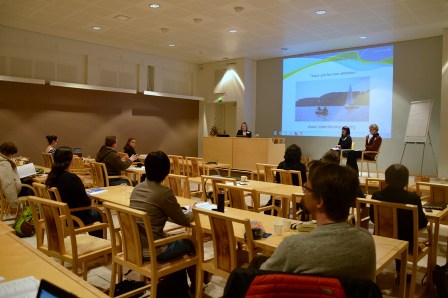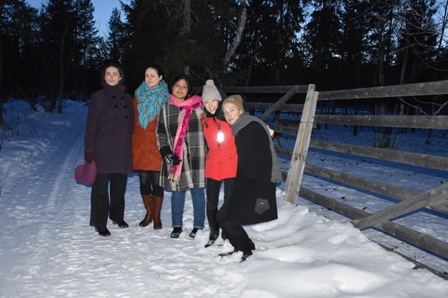Researchers take part in conferences and seminars on regular basis. When your abstract is accepted and sufficient funds for travelling are granted, it’s time to book your tickets and prepare your presentation. On site, you are a guest and can enjoy the work being done by the organizers and focus on learning about the newest research done in your field. Sometimes you might get a chance to take a look on the arrangements from the other viewpoint when your home organization takes its turn to host a scientific event and you are assigned to a role in making the preparations to welcome the guests.
 The Arctic Centre organizes and hosts several scientific events such as conferences, seminars and workshops each year. One of the events organized annually are the Annual Research Seminars of the ARKTIS Doctoral Programme. This year’s seminar “Reconstructing Change and Resilience in Environmental and Social Conditions – What Can We Learn for the Future?” that took place in the beginning of April 2013 was the 11th in row.
The Arctic Centre organizes and hosts several scientific events such as conferences, seminars and workshops each year. One of the events organized annually are the Annual Research Seminars of the ARKTIS Doctoral Programme. This year’s seminar “Reconstructing Change and Resilience in Environmental and Social Conditions – What Can We Learn for the Future?” that took place in the beginning of April 2013 was the 11th in row.
In this seminar, five keynote speakers addressed the theme of the seminar from the viewpoints of different disciplines and with empirical studies from different parts of the Arctic. Professor Emerita Julie Cruikshank from the University of British Columbia, Canada told about glaciers in the oral histories of elderly indigenous women in northwestern North America. Dr. Hans Tømmervik from the Norwegian Institute for Nature Research, Norway, talked about the responses of Sámi reindeer herders to the socio-ecological changes such as the exceptionally harsh winter conditions and the border closures in mid and late 1800s. Dr. Øyvind Paasche, University of Bergen, Norway, presented problems and prospects of different methods for reconstructing glaciers. Knowledge about the dynamics of glaciers can provide important knowledge about past climatic changes up to millennial time scale. Research professor Bruce Forbes, Arctic Centre, described the multidisciplinary approach taken in the RISES project to track the connections between environmental changes and land-use in Fennoscandia and northwest Siberia. Dr. Gro Ween from the University of Aberdeen, UK, discussed the local ecological knowledge of fishermen, illuminated by the issue of climate change, with a comparative approach between arctic coasts in Norway and Alaska. All these, together with doctoral students’ presentations on their ongoing research projects, offered an opportunity for multifaceted learning and vivid discussions during the two-day event.
 But how did it come to this? How was this achieved? For organizing a successful seminar, several pieces have to fit or be assembled together, if expressed using Bruno Latour’s concepts. Some of the pieces are human – for instance keynote speakers – and some of them more than human, even material or immaterial, or hybrid, something in-between.
Each year, an organizing team is invited to take care of the planning and arrangements of the seminar. All the tasks are assigned and responsibilities distributed to the organizing team members. While some are responsible for designing the scientific theme, others ensure that the practicalities run smoothly throughout the seminar. As the purpose of doctoral programmes is to provide research education, including enhancing the transferable skills of the doctors-to-be, every year 1-2 PhD students of ARKTIS Doctoral Programme are invited to join the organizing team. In addition, other staff members of the host organization are involved: for instance communications professionals distribute the final versions of the press release to the media and IT support gives technical assistance during the seminar. Several tasks run simultaneously, in rhythm, to ensure a smooth preparation process.
The overall theme and description of the seminar is planned and formulated into a text. A call for papers is written and published. Keynote speakers with expertise on the theme are invited. Information on the event is distributed through various channels such as email lists, websites and personal academic networks in order to reach all interested persons. Internet-based registration systems collect the information needed about the participants, participants submit their abstracts and papers in time and coffees and lunches are ordered, keeping special diets in mind. Evening programme and seminar dinner is booked. All the information to be published in the seminar’s abstract and programme booklet is written in time and handed over to the editor of the book who then inserts the text into the template. Photos are selected and sent for the graphic designer who makes the cover. Finally the book arrives from the press in time and the conference folders can be put together. All the time, the participants are informed about the deadlines and other practical issues such as the time allocated for each presentation. Then airplanes, trains and bicycles bring the keynote speakers and other participants to Rovaniemi and the conference venue and the show can begin.
But how did it come to this? How was this achieved? For organizing a successful seminar, several pieces have to fit or be assembled together, if expressed using Bruno Latour’s concepts. Some of the pieces are human – for instance keynote speakers – and some of them more than human, even material or immaterial, or hybrid, something in-between.
Each year, an organizing team is invited to take care of the planning and arrangements of the seminar. All the tasks are assigned and responsibilities distributed to the organizing team members. While some are responsible for designing the scientific theme, others ensure that the practicalities run smoothly throughout the seminar. As the purpose of doctoral programmes is to provide research education, including enhancing the transferable skills of the doctors-to-be, every year 1-2 PhD students of ARKTIS Doctoral Programme are invited to join the organizing team. In addition, other staff members of the host organization are involved: for instance communications professionals distribute the final versions of the press release to the media and IT support gives technical assistance during the seminar. Several tasks run simultaneously, in rhythm, to ensure a smooth preparation process.
The overall theme and description of the seminar is planned and formulated into a text. A call for papers is written and published. Keynote speakers with expertise on the theme are invited. Information on the event is distributed through various channels such as email lists, websites and personal academic networks in order to reach all interested persons. Internet-based registration systems collect the information needed about the participants, participants submit their abstracts and papers in time and coffees and lunches are ordered, keeping special diets in mind. Evening programme and seminar dinner is booked. All the information to be published in the seminar’s abstract and programme booklet is written in time and handed over to the editor of the book who then inserts the text into the template. Photos are selected and sent for the graphic designer who makes the cover. Finally the book arrives from the press in time and the conference folders can be put together. All the time, the participants are informed about the deadlines and other practical issues such as the time allocated for each presentation. Then airplanes, trains and bicycles bring the keynote speakers and other participants to Rovaniemi and the conference venue and the show can begin.
 I have been a member of the organizing team of the ARKTIS Annual Research Seminar three times, with various tasks from co-editing the abstract book to inviting keynote speakers, producing information for the seminar website, co-writing the overall theme description and call for papers of the seminar and passing on my knowhow on the book editing process. That’s what inspired me to write this blog text about a scientific event from an organizing team member’s perspective.
I have been a member of the organizing team of the ARKTIS Annual Research Seminar three times, with various tasks from co-editing the abstract book to inviting keynote speakers, producing information for the seminar website, co-writing the overall theme description and call for papers of the seminar and passing on my knowhow on the book editing process. That’s what inspired me to write this blog text about a scientific event from an organizing team member’s perspective.
For the participants of the seminar many steps that have been taken for arranging the seminar and processes running behind the scene remain invisible. This is also the idea of a Latourian black box where several bits and pieces form an entity and, in a way, the whole is greater than the sum of its parts. When the seminar arrangements work well, the black box remains intact. However, should some part of the arrangements fail, the box and the components it comprises become visible. The process of organizing a scientific event faces several trials of strength, but perhaps the most crucial one in terms of scientific significance and success takes place when all the arrangements have been made, participants arrive and it’s time for the show to begin. That’s when also the participants can join the actor-network of the seminar.
The beauty of a truly multidisciplinary seminar is in its ability to inspire, give new insights and foster new, deeper and wider understanding on the theme addressed and perhaps also on science in general. In my opinion, the ARKTIS Annual Research Seminar 2013 succeeded well in this. Thanks to all the participants of the seminar, the whole was greater than the sum of its parts.
Text by Ilona Mettiäinen